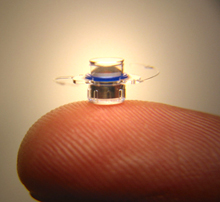Emory Eye Center is the first center in Georgia to offer a new technology proven to help the vision of some patients with end-stage age-related macular degeneration (AMD). The device was FDA approved in July 2010; Emory participated in the clinical trials that helped gain FDA approval. End-stage AMD can cause a loss of central vision, which is not helped by corrective lenses, pharmacotherapy or surgery. Currently, there is no cure for end-stage AMD.
Patients with end-stage AMD affecting both eyes may be candidates for the new device — an implantable miniature telescope — through the CentraSight™ treatment program, developed by VisionCare™, Inc.
Implantation in one eye is followed by rehabilitation training to learn how to effectively use the device. Rigorous screening is required to ensure good candidacy for the implant. Interested patients may contact VisionCare™ at the number below for complete information.
Emory Eye Center cornea surgeon John Kim will implant the device in patients who are candidates. "This new opportunity for those patients with end-stage AMD is exciting," says Kim. "Before now, there were no real options to improve their quality of life. With this surgery and subsequent therapy, the implant may provide them with the ability to do those everyday things we all take for granted such as seeing the faces of family members."
Evaluation process
Emory Eye's team of specialists will evaluate possible patients for device and study eligibility. Emory retina specialist Chris Bergstrom will medically evaluate potential candidates. Low vision expert Susan Primo, along with an occupational therapist, will evaluate patients' visual and functional characteristics, as well as their responsiveness to physical therapy before final approval. Not every patient with end-stage AMD is a candidate for the implant. Those patients who have had cataract surgery in the potential IMT eye are not eligible.
"Emory Eye Center is pleased to be the first center in Georgia to offer this new technology for those with end-stage AMD," says Emory Eye Center director Timothy W. Olsen. "Our team of retina specialists, surgeons, and low vision professionals will work together to help each patient reach his or her best outcome."
The surgery
The implant is inserted into the affected eye through the cornea and placed behind the iris. Images seen through the tiny telescope are reflected on the part of the macula that has not yet been affected by AMD. Only one eye is implanted; the other eye serves to provide the patient with needed peripheral vision. Over time, the two eyes learn to work together.
Post-implantation care
There is a long-term commitment of several months to effectively learn how to use the implant. Patients will receive several months of visual rehabilitation training and coordination of low vision care by the vision rehabilitation team. Most patients will still need a form of magnification and low vision devices to match specific functional goals.
As with any surgery, results may vary, and there may be risks. To better determine if you are a candidate for this surgery, call VisionCare's toll-free number at:
1-877-99-SIGHT (1-877-997-4448)

